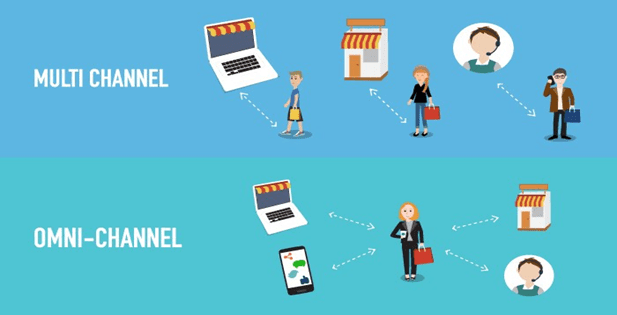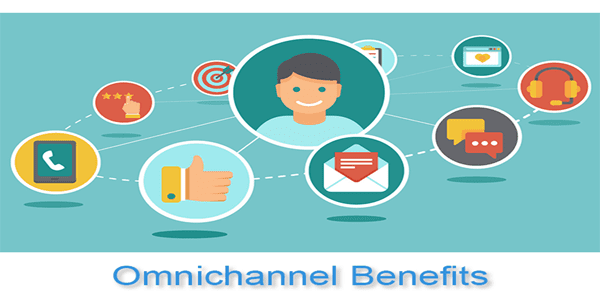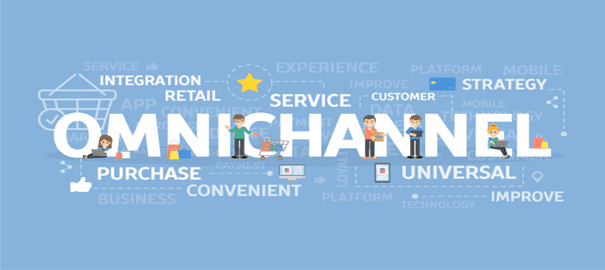Omnichannel Marketing Strategy for eCommerce

What is Omnichannel eCommerce?
It is an engagement approach in which a company gives access to its products, offers, and support services to customers on all platforms, channels, and devices.
Omnichannel operations focus on the entire customer experience—not only the customer’s individual experiences but also on different channels.
Why is Omnichannel eCommerce Important?
Some reasons why Omnichannel is important are: –
- Omnichannel E-Commerce Strategies Provide a Better Customer Experience.
- Omnichannel Is the Future of E-commerce
- Increase Customer Retention Rates and Sales

Omnichannel Vs Multichannel
The Key Difference are....
- Customer Experience
- Customer Centric
- Quality Of Customers support
- Customer Engagement
- Channel centric
- Quality of channels
1. Customer Experience and Customer Engagement:-
The main aim of multichannel marketing is to make a strong network as wide as possible to make more and more people aware of the business.
The aim of omnichannel marketing is to create a consistent customer experience for people who are already aware of engaging with a business.
Let’s put this difference in context
Take social media as an example. With a multichannel approach, the aim is to get more followers, comments, likes, and shares on your social media pages and posts – this shows how more and more people are engaging with your brand
On the opposite side, an omnichannel strategy will ensure that customers can jump from social media to your website. For instance, when they are on the Facebook ad, they are taken to the product page of your website, providing you with a seamless customer experience.
2. Channel-Centric vs Customer-Centric:-
Multichannel marketing aims to maximize the number of channels that are used to promote a brand. With more number channels, customers can choose how they want to engage with a business. The greater the number of channels offered, the more choice the customer has.
For omnichannel, the customer is the focus. The aim is to give a smooth and quick experience as they go from one channel to another. Less interconnected channels are better than more unconnected channels
In retail, for example, a multichannel focus would involve a large number of channels, such as digital marketing, including websites, paid
channels, TV, emails, social media, and even calls to promote the product and increase engagement.
In comparison, an omnichannel focus would involve just half of these channels, such as websites, email, and social media, and all of these would be synced up so that customers can smoothly move from one to the other.
3. Quantity vs Quality:-
As discussed above, multichannel is all about expanding the number of channels available. The more channels offered, the better. It increases the reach and allows customers to choose how to engage with a business.
Omnichannel is all about the quality of support offered through business channels. Customers can choose from whichever channel is liable to them and know that the quality of support they receive will be the same.
What are the Benefits of Omnichannel Ecommerce?
There is a wide range of advantages of applying an omnichannel sale strategy, although our aim is to give some advantages that are the most important for companies to achieve sales goals:

1. Cohesive Message
One of the major benefits of having omnichannel e-commerce is that you provide your customers with cohesive messaging about your brand. No matter where a customer will encounter your brand but the messaging is always the same.
2. Understanding your customer's journey
- Types of customers interested in your brand
- Understanding the behavior of customers
3. Personalizing the customer experience
Only by understanding the customer’s journey can you personalize your customers’ experience.
Omnichannel e-commerce helps you by creating a personalized experience which is essential for omnichannel customers as they have a 30% higher lifetime value than shoppers who can only purchase using one channel.
4. Target Specific Audiences:-
With proper customer and transaction analytics in place, marketing and retail experiences are free to focus on select target markets.
Customers who buy the generic brand of Cosmetics in a store can be given coupons for the higher-priced designer brand of Cosmetics to both bring them back and give them a chance to try a better Cosmetic product with a higher profit margin.
Inbound links can be used to tailor smart marketing campaigns on the web and in apps for specific groups of people.
5. High Customer Retention and Loyalty:-
Consumers will always buy from a brand that they trust. Omni-channel marketing provides a consistent experience for customers across different platforms.
Each platform has its unique and personalized message for different consumers (remember the last Sushi vendor? ).
6. Smoother Customer Journey:-
It is nothing but understanding your users, and how they behave across your sales funnel will certainly improve performance and shrink the drop-out points in the customer’s journey.
And also gives many ways and tips to improve your customer’s business journey.
7. Instant Revenue Growth:-
Increased ROI (Return on Investment) is one of the most important measures in any marketing that is very hard to achieve.
With accurate segmentation and personalization, an omnichannel marketing strategy can be very successful.
Higher customer engagement will lead to more conversions and a higher ROI.
8. More Integrated Business: -
Omnichannel has one amazing advantage —instead of having different units working for each of their separate goals, here you have a system of various units working together for one goal.
So, you will have integrated customer service, sales, marketing, and inventory resource planning working together towards a single goal.
9. tips for creating an omnichannel strategy are:-

- Focus on increasing personalized services
- Focus on creating memorable in-store experiences
- Incorporating interactive technology
- Concentrate on training/ reskilling staff
- Invest in consumer insights
- Digitalize the store
- Map the entire customer journey
- Turbo-charge your social media presence
- Using AI and chatbots to provide better customer service
- Collect and analyze data to find brand advocates
What are the Challenges with Omnichannel eCommerce?
Brick and Mortar Store Stock vs Online Stock
This is not always the best approach as it uses online transactions. A good way of fixing this problem is to reduce the availability of “best-selling” available items in your online stores.
Lack of Infrastructure
Finding the Right Transportation
Great success for your ICO can be anticipated from rigorous public relations and advertising efforts. We are a group of experts from different fields who work together to give our clients outstanding service at every stage of a product’s lifecycle.
Unreliable Order Fulfillment Processes
When a business tells its customers that they will receive the same-day or next-day delivery, it needs to be delivered on that promised day.
An unreliable order fulfillment process can lead to shipping delays, which can prevent customers from doing business with the company in the future.
A good way to ensure the order fulfillment process is to use the proper technology to help forecast future delays in service or shipping.
Omnichannel E-commerce Solutions:-
Customizable Strategy
We gain all the knowledge required for your business and according to the requirements our technology can be customized to meet your unique needs.


Mobile-Ready
According to your business requirements, we built responsive sites for you that are optimized for mobile and apps which support both IOS and Android.
Enterprise Integration
Oure-commerce site is designed from the ground up with industry standards in mind to facilitate integration with your existing inventory, warehouse, and finance system.


Online Marketing Ready
Here we reach out to potential customers at all the touchpoints with our solutions that drive engagement and sales by integrating major online marketing channels such as Google Ads, Facebook advertisements, affiliate marketing, shop back, and many more.
Scalability
Maintaining a high uptime and low response time with a system that scales dynamically as your operations grow is very necessary.
Our cloud architecture helps you to scale up on demand based on your business needs.




